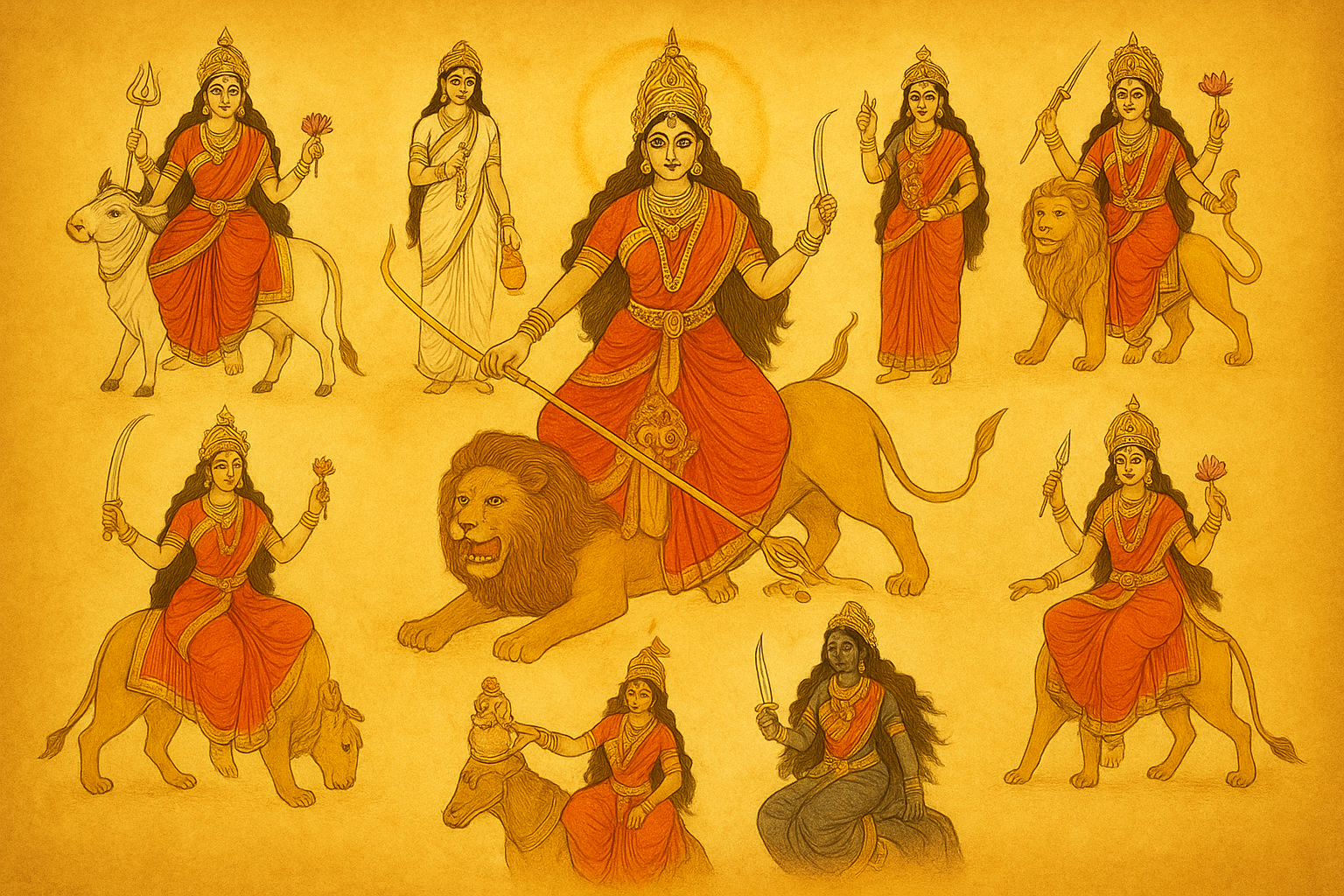Introduction
India is a land where every festival has a deeper spiritual meaning, and among the most celebrated is Sharadiya Navratri. This nine-day festival, held in the Hindu month of Ashwin (September–October), is dedicated to Maa Durga, the supreme goddess of power, protection, and victory. Each day of Navratri honours one of her nine divine forms, known as Navadurga.
The festival concludes with Dussehra (Vijayadashami), celebrated as the victory of good over evil—when Goddess Durga defeated the demon Mahishasura and when Lord Rama triumphed over Ravana. Together, Navratri and Dussehra remind us that while evil may rise, truth and righteousness always prevail.
Why is Sharadiya Navratri Celebrated?
There are two main reasons behind the celebration of Sharadiya Navratri:
- Victory of Goddess Durga over Mahishasura
Mahishasura, a demon king blessed with immense power, began tormenting the heavens and earth. To end his tyranny, the divine energies of all gods united to create Maa Durga. After a fierce nine-day battle, she slew Mahishasura on the tenth day, symbolizing the triumph of divine energy (Shakti) over evil.
- Victory of Lord Rama over Ravana
In another tradition, Lord Rama worshiped Goddess Durga during Navratri to gain strength before his war against Ravana. On the tenth day, he killed Ravana, marking the victory of dharma (righteousness) over adharma (evil).
Thus, Navratri is a celebration of courage, devotion, and truth, inspiring people to remove negativity from their lives and embrace goodness.
The Nine Forms of Maa Durga and Their Significance
Each day of Navratri is dedicated to one form of Navadurga, and devotees worship her with specific prayers, colours, and rituals:
- Day 1 – Maa Shailputri (Daughter of the Mountains):
Symbol of strength and stability. Worshiping her blesses devotees with courage and determination.
- Day 2 – Maa Brahmacharini:
Embodiment of devotion and penance. She inspires wisdom, knowledge, and discipline in life.
- Day 3 – Maa Chandraghanta:
Known for her fierce warrior form. She protects devotees from fear and blesses them with bravery.
- Day 4 – Maa Kushmanda:
Believed to have created the universe with her smile. She grants health, energy, and prosperity.
- Day 5 – Maa Skandamata:
Mother of Lord Kartikeya. She represents love and nurturing power, blessing devotees with strength and happiness.
- Day 6 – Maa Katyayani:
A warrior goddess born to Sage Katyayan. She symbolizes valor and grants victory over obstacles.
- Day 7 – Maa Kalaratri:
Fierce and powerful, she destroys evil and removes fear, negativity, and darkness.
- Day 8 – Maa Mahagauri:
Symbol of purity, serenity, and forgiveness. She brings calmness, peace, and spiritual growth.
- Day 9 – Maa Siddhidatri:
The giver of supernatural powers and success. Worshiping her fulfils desires and grants knowledge.
Why Navratri is Called the Victory of Good Over Evil
The essence of Navratri and Dussehra lies in the eternal truth that goodness always wins over evil:
- The story of Maa Durga vs Mahishasura shows how arrogance and tyranny are destroyed by divine feminine power.
- The story of Lord Rama vs Ravana teaches that ego, greed, and lust ultimately lead to downfall, while truth, courage, and devotion lead to victory.
This is why Navratri is considered not just a festival, but also a spiritual reminder of inner strength, righteousness, and self-discipline.
Dussehra: The Grand Finale
The tenth day, Dussehra or Vijayadashami, concludes the festival with celebrations across India:
- In North India: The festival is marked by Ramlila performances and the burning of Ravana’s effigies, symbolizing the destruction of evil.
- In Eastern India (West Bengal, Assam, Odisha): Durga Puja is celebrated with grandeur, and idols of Maa Durga are immersed in rivers on this day.
- In Southern India: Dussehra is observed as Ayudha Puja, where tools, books, and instruments are worshiped.
- In Western India (Gujarat, Maharashtra): People celebrate with energetic Garba and Dandiya Raas dances every night.
Conclusion
Sharadiya Navratri 2025 is more than a religious festival—it is a cultural and spiritual journey. The nine forms of Maa Durga teach us lessons of courage, purity, devotion, and victory over negativity. The celebration of Dussehra inspires us to live with truth, righteousness, and goodness.
As we celebrate this sacred festival, let us remember that no matter how strong evil appears, light will always triumph over darkness, and virtue will always overcome vice.

Leave a Reply